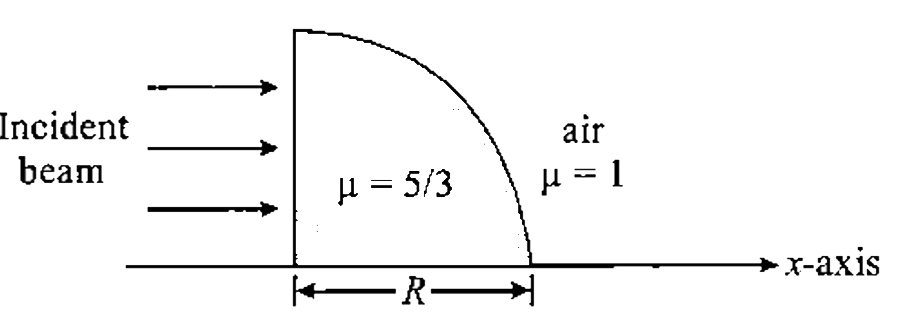A uniform, horizontal parallel beam of light is incident upon a prism as shown. The prism is in the shape of a quarter cylinder, of radius 5cm, and has refractive index 5/3. The width of the regionat which the incident rays after normal incidence on plane surface and subsequent refraction at curved surface intersect on x axis is (Neglect the ray which travels along x-axis)

The correct Answer is:D
The ray first above x-axis shale after refraction at cured surface intersect x-axis at A at a distance from where
or

critical angle for air glass
Range width
Topper's Solved these Questions
Similar Questions
A uniform,horizontal beam of light is incident upon a quarter cylinder of radiusR=5cm and has a refractive index 2/√3.A patch on the table for a distance 'x'from the cylinder is unilluminated ,find the value of 'x'?

View SolutionA ray of light is incident on the glass prism at an angle of 40∘. Find the angle of emergence, if the angle of prism is 60∘ and refractive index is 1.5.
View Solution
Knowledge Check
A parallel narrow beam of light is incident on the surface of a transparent hemisphere of radius R and refractive index μ=1.5 as shown. The position of the image formed by refraction at the image formed by refraction at the spherical surface only as
 AR2B3RCR3D2R
AR2B3RCR3D2RA parallel beam of light is incident normally on the flat surface of a hemisphere of radius 6cm and refractive index 1.5, placed in air as shown in figure (i). Assume paraxial ray approxiamtion.
 .AThe rays are focused at 12cm from the point P to the right, in the solutation as shown in figure (i)BThe rays are focused at 16cm from the point P to the right, in the situation as shown in figure (i).CIf the rays are incident at the curved surface (figure (ii)) then these are focused at distance 18cm from point P to the rightDIf the ray are incident at the curved surface (figure(ii)) then these are focused at distance 14cm from point P to the right.
.AThe rays are focused at 12cm from the point P to the right, in the solutation as shown in figure (i)BThe rays are focused at 16cm from the point P to the right, in the situation as shown in figure (i).CIf the rays are incident at the curved surface (figure (ii)) then these are focused at distance 18cm from point P to the rightDIf the ray are incident at the curved surface (figure(ii)) then these are focused at distance 14cm from point P to the right.When a ray of light is incident normally on one refracting surface of an equilateral prism of refractive index 1.5, then
Athe ray undergoes total internal reflection at the second refracting surface of prismBemergent ray is deviated by 30∘Cemergent ray is deviated by 60∘Demergent ray just grazes the second refracting surface of the prism
A ray of light is incident normally on one of the equal faces of a right isosceles prism of refractive index 1.5. The angle between incident and emergent rays is
View SolutionA parallel beam of monochromatic light is incident on the surface of water having refractive index 4/3. The direction of the incidence beam bisects the angle between the normal to the water surface and the water surface. The angles of incidence and refraction are
View SolutionAngle of a prism is 30∘ and its refractive index is √2 and one of the surface is silvered At what angle of incidence a ray should be incident on one surface so that after reflection from the silvered surface it retraces its path
View SolutionAngle of a prism is 30∘ and its refractive index is √2 and one of the surface is silvered. At what angle of incidence, a ray should be incident on one surface so that after reflection from the silvered surface, it retraces its path ?
View SolutionWhen a ray of light is incident normally on one refracting surface of an equilateral prism (Refractive index of the material of the prism =1.5
View Solution
